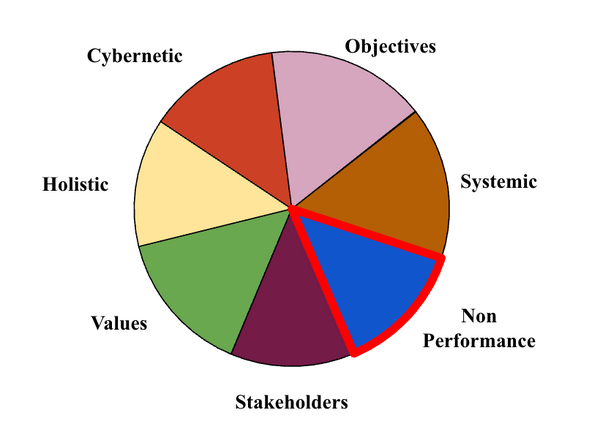Non Performance
Non-Performance is one of seven approaches used to manage individual and organizational performance that we've identified at GRI. The non-performance model is defined on the assumption that it is easier, more precise, consensual, and beneficial to address performance by problems and faults than by skills and performance criteria[1].
In this approach, performance is seen as a continuum from non-performance to high performance. An organization is performing when it is freed from non-performing characteristics. The construct of non-performance is smaller and more easily identifiable than the construct of performance. Preferences on non-performance are more easily identifiable and more consensual. Organizational improvement is more likely when knowledge of problems is present rather than knowledge of successes.
Measures of performance and non-performance of an organization are comparable to those of the physical health of a human being. At one end is excellent physical condition. Indicators of this condition can be low heart rate, high breathing capacity, high muscle tone, low fat, 20/20 vision, absence of cavities in the teeth, etc.
The other end of this scale is disease, as may be indicated by the inability of the body to function properly and, as a result, the presence of abnormal symptoms such as congestion, infection, bleeding, etc. Between these two extremes is a condition of normal health or balance. The body has an absence of disease but does not necessarily possess the characteristics of excellent health. A person may be overweight and require eyeglasses, yet their physical health would be considered acceptable. Physical health, therefore, is generally defined as the absence of the characteristics of disease. But to be judged in excellent health, additional characteristics must be taken into account.
The performance of organizations can be thought of in a similar way. The characteristics that indicate performance are different and at the extreme from those that indicate non-performance. That is, both the absence of non-performance characteristics and the absence of high-performance characteristics indicate baseline performance or balance. But to assess one end of the scale as opposed to the other end, characteristics must be considered and their qualities specified. We find these two opposite tendencies in Herzberg's two-factor model. The factors that improve satisfaction (accomplishment, recognition, responsibility, etc.) are different from those that reduce it (benefits, security, salary, etc.)[2].

